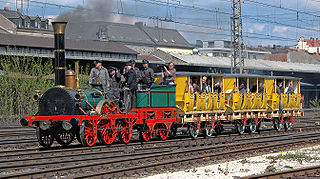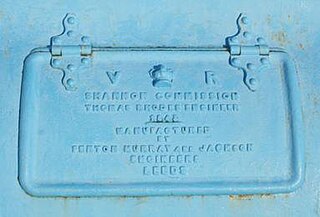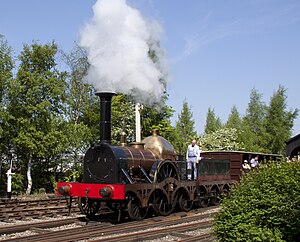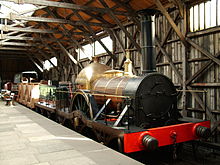
James Hall Nasmyth was a Scottish engineer, philosopher, artist and inventor famous for his development of the steam hammer. He was the co-founder of Nasmyth, Gaskell and Company manufacturers of machine tools. He retired at the age of 48, and moved to Penshurst, Kent where he developed his hobbies of astronomy and photography.
John Viret Gooch FRSA was the locomotive superintendent of the London and South Western Railway from 1841 to 1850. Born at Bedlington, Northumberland, John Viret Gooch was the son of John and Anna.

Under the Whyte notation for the classification of steam locomotives, 2-2-2 represents the wheel arrangement of two leading wheels on one axle, two powered driving wheels on one axle, and two trailing wheels on one axle. The wheel arrangement both provided more stability and enabled a larger firebox than the earlier 0-2-2 and 2-2-0 types. This wheel arrangement is sometimes described as a Single, although this name could be used to describe any kind of locomotive with a single pair of driving wheels.

The Great Western Railway (GWR) Star Class of 2-2-2 broad gauge steam locomotives were used for passenger train work. Designed by Robert Stephenson, the class was introduced into service between November 1838 and November 1841, and withdrawn between April 1864 and September 1871.

The Great Western Railway Premier Class 0-6-0 broad gauge steam locomotives for goods train work. This class was introduced into service between February 1846 and May 1847, and withdrawn between March 1866 and June 1872.
The Great Western Railway Hawthorn Class were 2-4-0 broad gauge steam locomotives for passenger train work. This class was introduced into service in 1865, a development of the Victoria Class.
Naismith, Nasmith, Nasmyth, or Naysmith may refer to:

The Great Western Railway Leo Class2-4-0 was a class of broad gauge steam locomotives for goods train work. This class was introduced into service between January 1841 and July 1842, and withdrawn between September 1864 and June 1874.

The Great Western Railway Sun Class were 2-2-2 broad gauge steam locomotives for passenger train work. This class was introduced into service between April 1840 and January 1842, and withdrawn between January 1864 and June 1879.

Nasmyth, Gaskell and Company, originally called The Bridgewater Foundry, specialised in the production of heavy machine tools and locomotives. It was located in Patricroft, in Salford England, close to the Liverpool and Manchester Railway, the Bridgewater Canal and the Manchester Ship Canal. The company was founded in 1836 and dissolved in 1940.

Fenton, Murray and Jackson was an engineering company at the Round Foundry off Water Lane in Holbeck, Leeds, West Yorkshire, England.
Little information remains about the North Midland Railway Locomotives. Unlike other railway companies, the North Midland Railway of England did not give names to its locomotives.
The Comet class were 12 4-4-0ST broad gauge locomotives operated on the South Devon Railway and associated railways. They were designed for passenger trains on this steep and sharply curved line but were also used on goods trains when required.

The GWR Hercules Class were four broad gauge steam locomotives for the Great Western Railway. They were its first 0-6-0 locomotives, being built in 1842 by Nasmyth, Gaskell and Company stemming from the company's need for goods locomotives. This resulted in the last four Firefly Class locomotives being modified while still in production. From about 1865, the Hercules Class locomotives became part of the Fury Class, along with the Premier Class locomotives. They were withdrawn between 1870 and 1871.
The first 19 locomotives ordered by Isambard Kingdom Brunel for the Great Western Railway included six 2-2-2 Charles Tayleur locomotives. They were built by Charles Tayleur and Company, which became later the Vulcan Foundry. The locomotives were unsuccessful and rapidly supplemented by the Star Class locomotives ordered by Daniel Gooch once he had been appointed as the Locomotive Engineer. As built, they comprised two groups of three: the first group, delivered in 1837, had cylinders having a bore of 14 inches (360 mm) and the second group, delivered in 1838, had cylinders having a bore of 12 inches (300 mm); all had a stroke of 16 inches (410 mm).

The first 19 locomotives ordered by Isambard Kingdom Brunel for the Great Western Railway included six 2-2-2 Mather, Dixon locomotives. They were built by Mather, Dixon and Company, but were unsuccessful, and were rapidly replaced by the Star Class locomotives ordered by Daniel Gooch, once he had been appointed as the Locomotive Engineer.
The Munich–Augsburg Railway Company, the second private railway company in Bavaria, built the Munich–Augsburg line between 1838 and 1840. It was nationalised in 1846 and became part of the Royal Bavarian State Railways, subsequently forming part of the Bavarian Maximilian’s Railway built between 1851 and 1854.

Swiftsure was first of eight or more similar locomotives with a single pair of driving wheels built by George Forrester and Company (Forresters) from 1834. The tank variant was the first passenger tank engine to enter service in the world.












